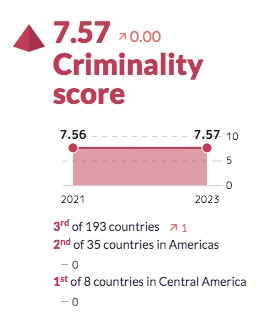In our globalized world, events in one region can resonate globally. The last three decades have seen globalization drive prosperity and create vast opportunities [1]. However, this openness has also allowed organized crime to flourish, capitalizing on new markets, supply chains, and technologies while leveraging weak regulation in financial systems and digital spaces [2].
Consequently, substantial wealth has accrued to criminal organizations and corrupt entities. A collective international approach is essential to tackle such a pervasive issue as organized crime. Nonetheless, despite existing efforts, illicit activities have dramatically evolved and expanded globally over the last twenty years, posing significant threats to peace, development, environmental sustainability, health, and justice across the globe

What dynamics have contributed to the growth of illicit markets? Rapid technological advancements and the slow pace of regulatory adaptation have been critical factors. The internet has particularly facilitated the expansion of illegal economies, enabling the sale of weapons, drugs, and human trafficking through social media and communication applications.
Additionally, it has become a rich data source for engaging in corruption, extortion, and other criminal activities. Conventional forms of connectivity, such as the increased volume of container shipping, more frequent flights, and enhanced infrastructure, have also played a role. These activities have had devastating effects on our environment, with illegal logging, unregulated fishing, and poaching disrupting natural ecosystems [3]. Moreover, illicit mining and drug cultivation are harming forests, contaminating water sources, and exhausting our planet’s limited natural resources [4].

Factors Driving the Expansion of Illicit Markets
Demographic changes and increased mobility also drive illicit markets. Urban migration has overwhelmed many cities’ capacity to provide essential public services and security, leading to the expansion of slums, where criminal organizations often step in to offer alternative governance and services.
Simultaneously, factors like war, poverty, and climate change have forced millions to flee their homes, creating opportunities for smugglers who find ways to circumvent barriers like border walls and legal migrations. Furthermore, growing inequality has exacerbated these issues, with the wealthy accruing more and leaving others behind.

The decline in legitimate employment opportunities has pushed more individuals towards criminal economies that exploit the vulnerable. This problem is intensified by financial secrecy, tax havens, and cryptocurrencies that facilitate opaque financial transactions.
Conflict zones provide fertile ground for illicit trade in weapons, oil, drugs, and natural resources, and even stable democracies are not immune, as organized crime can influence democratic processes through financial power in election campaigns.
New Strategies to Combat Traffickers
Given these challenges, a pressing global need exists to combat illicit activities that exacerbate major global crises. Sustainable development, good governance, migration management, and lasting peace are unattainable without effectively tackling illicit markets and organized crime. Operations research (OR) and data analytics methodologies are some of the many tools that can help to disrupt these illicit markets [5].
It aims to advance techniques in behavior analysis on social networks, criminal profiling, crime detection, interagency data sharing, sentiment and misinformation analysis, media planning, trend detection and tracking, network interdiction, visualization and modeling, weak signal detection, predicting activity locations, social media analysis, community detection, authority discovery, and supply chain inspection. For instance, predictive analytics can forecast crime hotspots and trends, enabling preemptive actions.
Network analysis tools can unravel criminal organizations’ complex relationships and hierarchies, aiding in their dismantlement. Moreover, machine learning models can identify patterns of illegal activities from vast data sources, improving the detection and prevention of crimes such as fraud and smuggling. Enhancing interagency collaboration through shared data systems facilitates a more coordinated and timely response to criminal threats.

Integrating OR and analytics into the fight against organized crime and illicit markets is crucial for developing adaptive strategies informed by real-time data and predictive insights, ensuring a robust defense against these global threats. However, their application comes with challenges, such as ensuring data quality, mitigating algorithmic bias, and respecting ethical considerations.
As the field progresses, advancements in artificial intelligence (AI) hold promise for even more sophisticated crime prediction and prevention. Additionally, developing explainable AI models can improve transparency and trust in these systems. Ultimately, successful implementation requires collaboration between researchers, policymakers, and law enforcement to leverage data analytics effectively in the fight against organized crime.
References
[1] Green, D., & Griffith, M. (2002). Globalization and its discontents. International Affairs, 78(1), 49-68.
[2] Andreas, P. (2004). Illicit international political economy: the clandestine side of globalization. Review of International Political Economy, 11(3), 641-652.
[3] Nellemann, C., Henriksen, R., Kreilhuber, A., Stewart, D., Kotsovou, M., Raxter, P., … & Barrat, S. (2016). The rise of environmental crime: a growing threat to natural resources, peace, development and security. United Nations Environment Programme (UNEP).
[4] Fathi, M., Pardalos, P. M., Delen, D., Gold, S., & Khakifirooz, M. (2024). An Introduction to the Applications of Operations Research and Data Science in Disrupting Illicit Markets. Annals of Operations Research, In Press.
[5] Anzoom, R., Nagi, R., & Vogiatzis, C. (2021). A review of research in illicit supply-chain networks and new directions to thwart them. IISE Transactions, 54(2), 134-158.
Author
Marzieh Khakifirooz. Ph.D. in industrial engineering and engineering management and M.S. in industrial statistics from National Tsing Hua University (NTHU), Hsinchu, Taiwan. She is an Assistant Professor at the School of Engineering and Sciences, Tecnologico de Monterrey, Mexico. She has outstanding practical experience from her various global consultancies for high-tech industries and numerous publications in AI-based decision-making.















